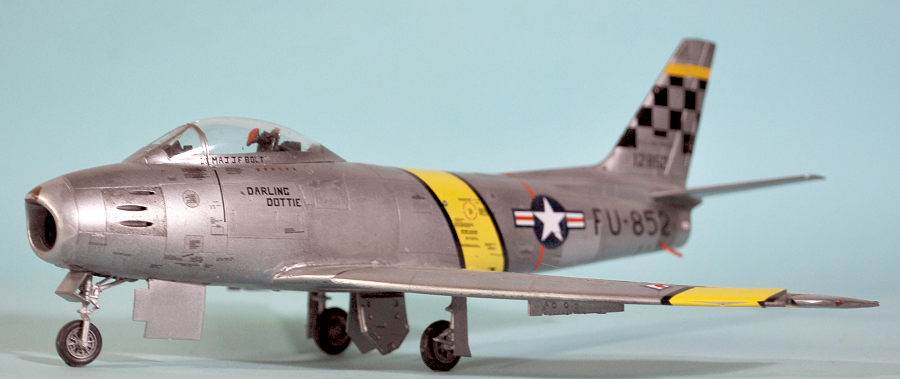
Hasegawa 1/48 F-86E Sabre
| KIT #: | 7213 |
| PRICE: | $45-65.00 'Used' |
| DECALS: | Two options |
| REVIEWER: | Tom Cleaver |
| NOTES: | Red Roo F-86E resin wing and Warbird Decals 48026 “Korean War F-86s Part 1" |

| HISTORY |
The F-86 Sabre was the first really successful US jet fighter. 9,800 Sabres were produced between 1949-56 in the U.S., Canada, Japan, Italy and Australia. The F-86A was capable of supersonic flight in a dive, though the airplane was actually out of control, flying beyond its critical mach number, when it accomplished that feat. It was only due to the fact that by chance (since the aerodynamic rules of supersonic flight were unknown at the time of the F-86's initial design) the horizontal stabilizers were located at the right position on the fuselage below the vertical stabilizer, but high enough not to be blanked by vortices from the wing, while also being large enough not to be blanked by the supersonic shock wave off the nose, that he pilot could maintain enough control not to crash in a supersonic dive.
The F-86E solved the problems of the F-86A by adopting the “all-flying
tail” that was developed during the X-1 supersonic flight program. The entire
horizontal stabilizer moved as an elevator, with the elevator moving as a
control tab at higher speeds, thus maintaining controlled flight through Mach 1.
This system was so successful that when the Soviets recovered Bud Mahurin’s
crashed F-86E from North Korea in 1952 and transported it to the USSR for study,
the North American designed all-flying tail was adopted for all Soviet
supersonic fighters and can be found on Russian aircraft to this day. The
Soviets also copied the F-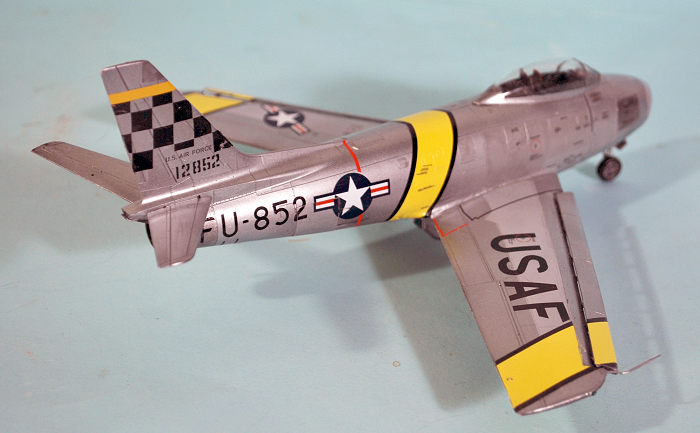 86E’s ASP-4N optical gunsight and the SRC-3
radar-ranging gear used by the gunsight, using it on the MiG-17. The all-flying
tail used full power-operated controls with an "artificial feel" built in to
give the pilot forces on the stick that were still conventional, but light
enough for superior combat control. This improved high-speed maneuverability,
allowing Sabres to initiate supersonic dive attacks (on the rare times when the
F-86 found itself flying higher than the MiG-15).
86E’s ASP-4N optical gunsight and the SRC-3
radar-ranging gear used by the gunsight, using it on the MiG-17. The all-flying
tail used full power-operated controls with an "artificial feel" built in to
give the pilot forces on the stick that were still conventional, but light
enough for superior combat control. This improved high-speed maneuverability,
allowing Sabres to initiate supersonic dive attacks (on the rare times when the
F-86 found itself flying higher than the MiG-15).
In 1951, the need for Sabres in Korea became so critical that the Air Force ordered 60 Sabres from Canadair, which were delivered as the F-86E-5 (Can), a designation later changed to F-86E-6. All the Canadair-built Sabres were sent to Korea, where they formed the initial equipment of the 51st Fighter Interceptor Wing when the unit converted from the F-80 to the F-86. North American F-86Es replaced the F-86As in the 4th FIW. Interestingly, the Canadair-built Sabres were considered technically superior to the North American product.
While the F-86F that arrived in Korea beginning in the fall of 1952 soon changed the slatted wing for a “solid” leading edge known as the “6-3" wing for the change in the leading edge that increased chord and gave the Sabre the ability to fly and fight at higher altitudes than before, the slatted-wing F-86Es were still around in the spring of 1953 when the Rules of Engagement were loosened to allow “hot pursuit” of MiGs north of the Yalu (which had been happening unofficially and against the rules since 1951), as the MiG Alley air war heated up in the final months of the war.
Major John F. Bolt, USMC Sabre Ace:
Throughout the Korean War, Navy and Marine pilots, along with RAF pilots, served in the two Sabre wings. In fact, Navy Lt. Commander Paul Pugh came so close to embarrassing the Air Force by becoming the first “MiG Ace” in 1951 that he was removed from operations after scoring his third victory, to insure that an Air Force pilot gained that honor.
In 1952-53, the 51st FIW welcomed Marine pilots to gain Sabre experience as the Marines were about to receive the FJ-2 Sabre. Several Marine pilots gained single victories, with two being credited with 2 victories that spring.
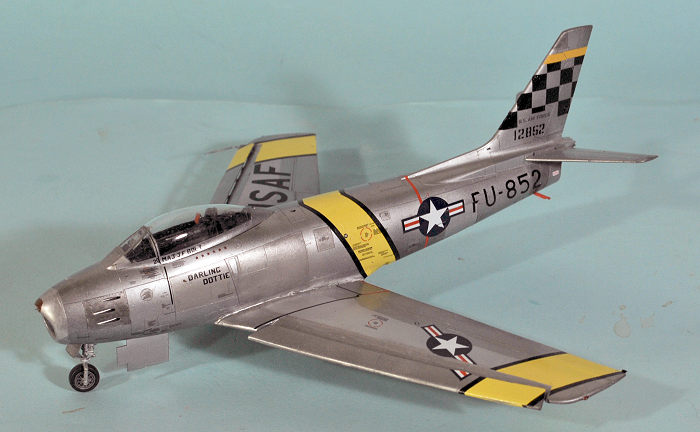 Major John F. Bolt, a World War II ace with six victories scored in the
Solomons with VMF-214 “Black Sheep,” arrived in the 51st wing in March 1953,
following completion of his Marine combat tour where he flew 94 missions in F9F
Panthers with VMF-115.
Major John F. Bolt, a World War II ace with six victories scored in the
Solomons with VMF-214 “Black Sheep,” arrived in the 51st wing in March 1953,
following completion of his Marine combat tour where he flew 94 missions in F9F
Panthers with VMF-115.
Bolt had previously served an exchange tour with the USAF 318th FIS, where he converted to the F-86. He joined the 39th FIS flight led by Joe McConnell, starting as Number 4 flying wing to McConnell after RAF Flight Lieutenant Roy French, McConnell’s previous wingman. Bolt moved up to element lead Number 3 in late April. After McConnell left for his “ace tour” at the end of May, Bolt took command of the flight.
Bolt finally met MiGs on May 16, 1953, on his 17th mission into MiG Alley. The flight crossed the Yalu and was attacked by MiGs at 45,000 feet; Bolt quickly found himself with MiG on his tail. He managed to evade and latched onto another MiG; hitting the enemy fighter in the engine, it caught fire and the pilot ejected.
Six days later on May 22, the flight was again north of the Yalu and came under attack from MiGs. Outmaneuvering the MiG on his tail again, he spotted another attacking his wingman and chased it to 7,000 feet, shooting it down near the Yalu.
A month later, flying his 31st mission on June 24, he caught a single MiG north of the Yalu and shot it down after a brief fight. A week later, north of the Yalu again on June 30, Bolt spotted and quickly shot down another MiG; his score was now four victories and two "damaged."
On July 11, Bolt flew his 37th mission, leading his flight across the Yalu above Sinuiju.The second element departed early due to low fuel; Bolt and his wingman remained and soon spotted four MiGs taking off from Antung. Bolt dived on them as they lifted off the runway and shot down the leader over the field with four bursts, the MiG crashing and exploding just beyond the field. He turned on the leader’s wingman and scored hits on the fuselage, forcing the enemy pilot to eject. The two Sabres then fled across the Yalu back into MiG Alley.
With a final score of six, Major John F. Bolt became the only non-USAF MiG Ace of the Korean War, the only USMC jet ace, and the only Naval Aviator to become an ace in two wars. He was awarded the Navy Cross for the feat, and returned to the United States at the end of the month.
| THE KIT |
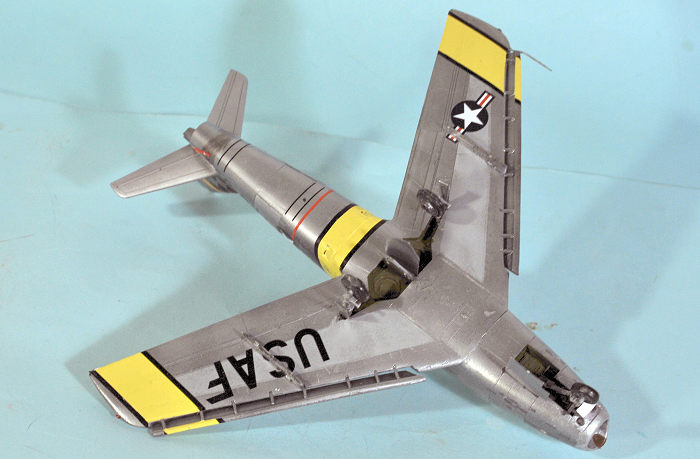 Hasegawa released their kit of an F-86F-30 Sabre in 1996. The kit was
released several times in limited releases for Korean War aces, RAF and RCAF
Sabres, and was updated with an extended wing and released as a JASDF F-86F-40
in two releases, the last a limited release in Blue Impulse flight team
markings. The kit is not in production at this time, but the various releases
can be found with eBay vendors, with prices ranging from $40-$65, depending on
the rarity of the release. This past May, several kits showed up at my LHS
estate sale at $30 each and quickly found a home here at Le Chateau du Chat.
Hasegawa released their kit of an F-86F-30 Sabre in 1996. The kit was
released several times in limited releases for Korean War aces, RAF and RCAF
Sabres, and was updated with an extended wing and released as a JASDF F-86F-40
in two releases, the last a limited release in Blue Impulse flight team
markings. The kit is not in production at this time, but the various releases
can be found with eBay vendors, with prices ranging from $40-$65, depending on
the rarity of the release. This past May, several kits showed up at my LHS
estate sale at $30 each and quickly found a home here at Le Chateau du Chat.
I don’t know why no company has released a kit of an F-86A or F-86E with slatted wings; from comments by modelers over the years, it would seem to be “a license to print money.” Cutting Edge released an F-86A conversion set in 2003, with a resin leading edge and slats, and different rear fuselage (they also did an F-86E conversion with the slats and an early canopy which I used in a 2011 build. Ed). Bill Scobie released a “narrow chord” slatted F-86E wing for the F-86A and E, and a “6-3" slatted wing for the Sabre Mk. 6, back in 2009, which were available for about two years.
Gary Byk at Red Roo Models bought the Scobie wings, and has released the narrow-chord slatted wing occasionally since 2019. He produces ten at a time, and makes new ones approximately every two years. When he did the last batch, I picked up the last two.
I had purchased the Warbirds Decals F-86 sheet 48026 a couple years ago, to do John Glenn’s “MiG Mad Marine.” The sheet also has John Bolt’s F-86E “Darling Dottie.” When I managed to snag the Red Roo slatted wings and score the five Sabre kits at the LHS, I decided I would do “Darling Dottie.”
| CONSTRUCTION |
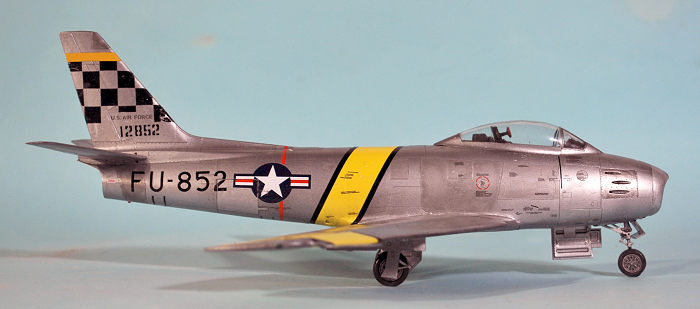 Hasegawa’s Sabre kit really benefits from a resin cockpit, or at least a
resin ejection seat. That big clear canopy lets you see a lot, once the model is
built. When I got the kits at the LHS, I also went up to eBay and bought two OOP
True Details F-86 cockpit and three Quickboost sets, since these sets have seats
with molded-on belts and other extra detail. I assembled and painted one and
installed it in the fuselage of this kit.
Hasegawa’s Sabre kit really benefits from a resin cockpit, or at least a
resin ejection seat. That big clear canopy lets you see a lot, once the model is
built. When I got the kits at the LHS, I also went up to eBay and bought two OOP
True Details F-86 cockpit and three Quickboost sets, since these sets have seats
with molded-on belts and other extra detail. I assembled and painted one and
installed it in the fuselage of this kit.
The F-86E wing has a narrower chord than the 6-3 wing that is in the kit. The Red Roo wing is drop-fit, but you have to fill in an area of about 1/8 inch at the forward end of the wing cutout area of the fuselage. I used Evergreen sheet for this. I had to fill that with Mr. Surfacer and sand the area smooth, then rescribe detail.
I decided to close the canopy on this model, since it is big and clear and one can see the cockpit detail as clearly as when the canopy is posed open. Once assembled, it was time to paint the model.
| COLORS & MARKINGS |
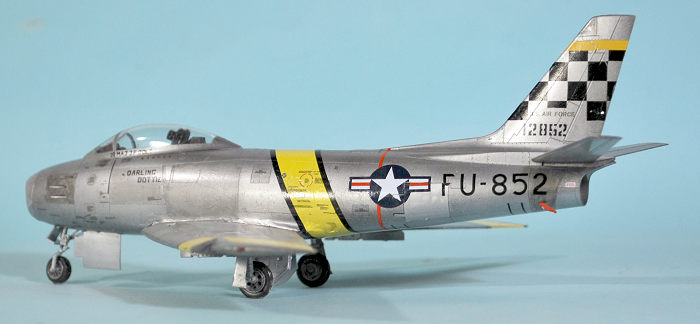 I applied a primer coat of Tamiya X-18 “Semi-Gloss Black,” misted on to
give a mirror finish. I then applied a “base coat” of Vallejo “Aluminum” and
allowed it to cure overnight. I then masked off the central section of the wings
and painted those areas with Vallejo “White Aluminum” with a dollop of Tamiya
Gloss White to give a more grayed-out color.
I applied a primer coat of Tamiya X-18 “Semi-Gloss Black,” misted on to
give a mirror finish. I then applied a “base coat” of Vallejo “Aluminum” and
allowed it to cure overnight. I then masked off the central section of the wings
and painted those areas with Vallejo “White Aluminum” with a dollop of Tamiya
Gloss White to give a more grayed-out color.
I brush painted the other smaller panels with Vallejo “Semi-Matte Aluminum” and “Dull Aluminum,” and painted the gun blast covers with Vallejo “Duraluminum.” The nose cap of an F-86 is silver plastic, which I created with Vallejo “White Aluminum.”
I used the Warbirds Decals 48027 “Sabre Markings” for the yellow ID stripes and stenciling, and the 48026 sheet for the specific markings for “Darling Dottie.”
I attached the wing slats and the landing gear, and called it done.
| CONCLUSIONS |
If you haven’t figured it out long ago, my two favorite jets are the F-86 Sabre and the F9F Panther. The opportunity to grab these five kits, and decals for Darling Dottie and some foreign Sabres, means I will finally have a collection ranging from the F-86A through the FJ-3, all sub-types and the major air forces the type flew with. If you want a slatted Sabre, since the model companies seem resolute in their desire not to make money, keep track of Red Roo Models website, and grab the wings when Gary releases them. You might leave him a comment requesting them, which could speed the next batch.
29 June 2023
Copyright ModelingMadness.com.
All rights reserved. No reproduction in part or in whole without express
permission.
Review kit and conversion items courtesy of all you book buyers. If you would like your product reviewed fairly and fairly quickly, please contact the editor
or see other details in the
Note to
Contributors. Back to the Main Page
Back to the Review
Index Page
Back to the Previews Index Page